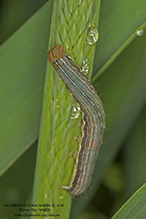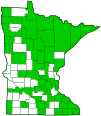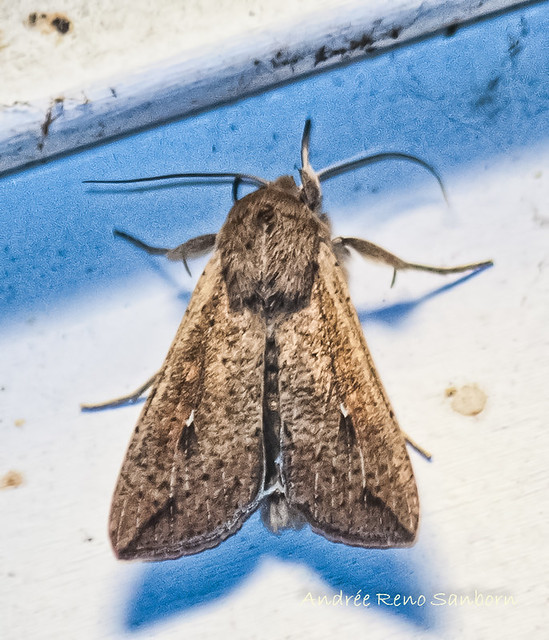armyworm moth
(Mythimna unipuncta)
Conservation • Description • Habitat • Ecology • Distribution • Taxonomy
|
|
||||||||||||||||||
Description |
Armyworm moth, also called true armyworm and the white speck. is a migratory wainscot moth. It is medium-sized for a moth, large for a wainscot moth. It occurs in Europe, northern Africa, Iceland, North America, Central America, and northern South America. It is common throughout the United States and Canada, common and sometimes abundant in Minnesota. It does not survive cold winters. Adults migrate south in the fall and a later generation disperses north in the spring. Adults are found in Minnesota from March to November. Larvae (caterpillars) feed on leaves and sometimes seed heads of mostly grains and other grasses in the family Poaceae, but also many broadleaf plants close to their infestations. They are often a serious agricultural pest, especially on wheat and corn. Adults are ¾″ to 1″ (20 to 25 mm) long and have a wingspan of 1⅜″ to 1⅞″ (35 to 47 mm). The forewing is long and somewhat pointed at the tip (apex). It is mostly tan with a peppering of dark scales. There is a gray line at the wing tip that extends diagonally inward less than half way across the wing, then becomes a line of black dots that continues to the inner margin. On some individuals, the triangular area beyond the gray line is tinted grayish. The discal cell is tinted reddish-orange from the base to the gray line. There are three noticeable horizontal lines; the antemedial (AM) line between the basal and median areas; the postmedial (PM) line that separates the median area from the postmedial area; and the terminal line at the outer margin. On some individuals, the AM line consists of a row of gray dots, one on each vein. On others, the AM line is absent. The PM line is a smoothly curved row of gray spots, one on each vein. The terminal line is a straight row of small gray spots. There is a circular spot in the upper median area (orbicular spot) and a kidney-shaped spot at the end of the discal cell (reniform spot). Both spots have broad pale border with a small center the same color as the background. On some individuals both spots inconspicuous or absent. There is no wedge-shaped spot near the inner margin (claviform spot). The cubital (Cu) vein is often white. There is always a small but conspicuous white spot at the outer (distal) end of the Cu vein), and often a small gray area just beyond the spot. The hindwings are grayish-brown, pale at the base grading to dark at the tip. The veins and discal spot are dark. The head and thorax are a similar color to the forewings but darker. On the upper side of the thorax there is a tuft of hairs that is dark just behind the head, otherwise the same color as the forewing. The antennae are threadlike on both the male and the female. The eyes are covered with fine hairs. The pair of small, finger-like processes (labial palps) curving up from the lower part of the head are long, extending at least to the middle of the face. The caterpillar is up to 2″ long. |
Size |
Total length: ¾″ to 1″ (20 to 25 mm) Wingspan: 1⅜″ to 1⅞″ (35 to 47 mm) |
Similar Species |
Habitat |
Fields, meadows, gardens, and agricultural crops |
Ecology |
Season |
Two or three generations per year: March to November |
Behavior |
Adults are active at night and will come to lights. After defoliating a stand of plants, the larvae will move as a group to a nearby stand and resume feeding. |
Life Cycle |
|
Larva Hosts |
Leaves and sometimes seed heads of mostly grains and other grasses in the family Poaceae, but also many broadleaf plants close to their infestations. |
Adult Food |
Flower nectar |
Distribution |
||
|
Sources 21, 24, 27, 29, 30, 71, 75, 82, 83. Biodiversity occurrence data published by: Minnesota Biodiversity Atlas (accessed through the Minnesota Biodiversity Atlas Portal, bellatlas.umn.edu, 6/18/2025). |
|
| 6/18/2025 | ||
Occurrence |
||
Common, sometimes abundant |
||
Taxonomy |
|
Order |
|
Superfamily |
Noctuoidea (Owlet Moths and Allies) |
Family |
Noctuidae (cutworm moths and allies) |
Subfamily |
|
Tribe |
Leucaniini (wainscot moths) |
Genus |
Mythimna |
Subgenus |
Pseudaletia |
Subordinate Taxa |
|
|
|
Synonyms |
|
Leucania antica Leucania extranea Leucania unipuncta Mythimna extranea Mythimna tseki Noctua unipuncta Pseudaletia unipuncta |
|
Common Names |
|
armyworm (caterpillar) armyworm moth (adult) common armyworm rice armyworm true armyworm the one-spot the white-speck white-speck moth |
|
Glossary
Antemedial (AM) line
A thin line separating the basal area and the median area of the forewing of Lepidoptera.
Palp
Short for pedipalp. A segmented, finger-like process of an arthropod; one is attached to each maxilla and two are attached to the labium. They function as sense organs in spiders and insects, and as weapons in scorpions. Plural: palpi or palps.
Orbicular spot
A circular spot or outline in the upper median area near the antemedial line on the forewing of many moths.
Postmedial (PM) line
A thin line separating the median area and the postmedial area of the forewing of Lepidoptera.
Reniform spot
A kidney-shaped spot or outline in the lower median area near the PM line on the forewing of many moths.
Visitor Photos |
||
Share your photo of this insect. |
||
This button not working for you? |
||
Alfredo Colon |
 |
MinnesotaSeasons.com Photos |
||
|
||
|

Visitor Videos |
||
Share your video of this insect. |
||
This button not working for you? |
||
|
Other Videos |
||
Armyworm Moth (Noctuidae: Mythimna unipuncta) Moved by Ant |
About
Aug 5, 2010 Photographed at Turtle River State Park, North Dakota (04 August 2010). |
Mythimna unipuncta |
About
Mar 5, 2019 |

Created: 12/28/2019 Last Updated: © MinnesotaSeasons.com. All rights reserved. |




